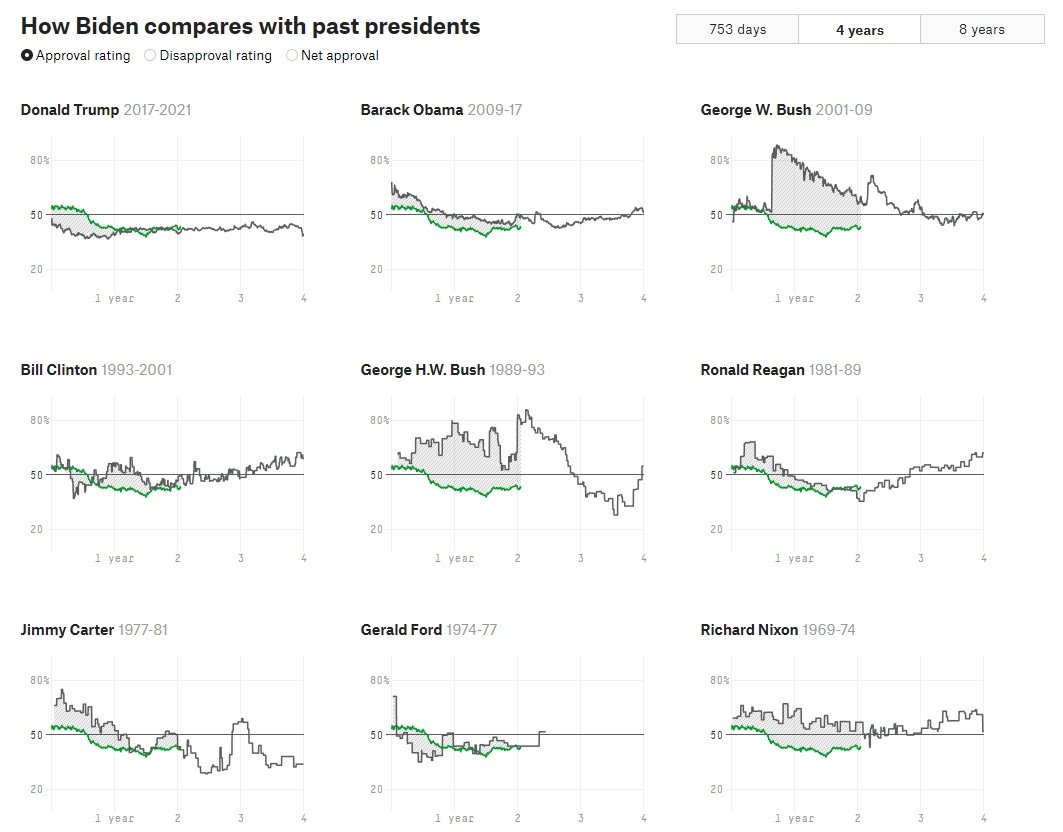The Long View 2009-01-25: Seigniorage & Other Matters

I’ve sometimes said that John wasn’t great with data, but what I mean is that he didn’t have the same kind of visual style I do. For example, in this blog post John said:
President Obama's approval ratings will, no doubt, soon fall into line with the historical precedents for a popular new president who everyone agrees must deal with problems that cannot be solved immediately.
What he didn’t do is link to or place an image in the post to illustrate his point. FiveThirtyEight, the website I took that image from, was only founded in 2008, but I think you could have found something similar in 2009.
The really striking thing about that chart is how popular the two President Bushes were in that metric.
Seigniorage & Other Matters
President Obama's approval ratings will, no doubt, soon fall into line with the historical precedents for a popular new president who everyone agrees must deal with problems that cannot be solved immediately. Michael Novak does not argue otherwise in his piece, The Coming Fall. He is, however, quite wrong to forecast that this natural erosion will be mitigated by this turn of events:
The run of good luck will show up when the economy slowly begins to turn upwards in June or July of this year, as the number of mortgage foreclosures of owner-occupied homes steadily falls. Mortgage companies are already resuming their traditional controls over credit, as in the more solid past, and they are now over-busy trying to handle a great wave of home-refinancing. Citizens are overwhelming national mortgage companies such as Wells Fargo (Des Moines) and USAA (the financial services company for the military, based in San Antonio) with applications for re-financing, as home owners rush to take advantage of the unusually low interest rates.
The misapprehension that the world economy ails from nothing more fundamental than a blip in the US real estate market darkens the understanding within the new Administration and outside it. No good will come of the effort to amend the situation by changing the burned-out fuse in the securitization bubble machine, if for no other reason than that such a policy deflects our attention from the fact The Treasury bond "bubble" looks like it's leaking air:
Over the last three weeks, investors have been selling U.S. Treasury bonds heavily, giving the 30-year Treasury bond's yield this week its biggest weekly jump since 2001, shortly after the Sept. 11 attacks on the United States.
There are several reasons for this, but the interesting one is that many of the world's major states seem to be planning to finance their fiscal deficits by borrowing more money than is actually available on a planet as small as Earth. Britain may be technically bankrupt at this point. The Eurozone is starting to look like Argentina just before the last time it repudiated its debt. That was in the 1990s, when its currency collapsed. There had been several years during which the country had enjoyed high growth and price stability under a currency-board system that, in effect, treated its US dollars as gold, against which local currency was issued. The flaw was that the system placed no controls on debt issued by the states, whose debt grew arbitrarily. When no more debt could be sold, the currency board had to be abandoned. Is it really impossible that what happened in Buenos Aires could happen at Frankfurt?
The US, however, has long since ascended to a celestial region where questions about supply and demand for US federal debt are impertinent, if not blasphemous. As the issuer of the world's reserve currency (which now, paradoxically, has no imaginable competitors), the US government can get away with quite a lot. The economist Kosuke Takahashi is worried that the US may press its luck, and succumb to the temptation of dollar seigniorage:
Seigniorage is the revenue that a government raises by printing money. Suppose it costs one dollar to print a US$100 bill. As long as the world deems this bill worth $100, the US government receives the revenue of $99 every time it prints out a $100 bill...
It's intriguing to note what Federal Reserve chairman Ben Bernanke, then Princeton University economics professor, said about seigniorage. He wrote in his Macroeconomics textbook, co-authored with Andrew Abel..."Governments that want to finance their deficits through seigniorage do not simply print money but use an indirect procedure. First, the Treasury authorizes government borrowing equal to the amount of the budget deficit, and a correspondent quantity of new government bonds are printed and sold. However, the new government bonds are not sold to the public. Instead, the Treasury asks (or requires) the central bank to purchase the [money] in new bonds. The central bank pays for its purchase of new bonds by printing [the money] in new currency, which it gives to the Treasury in exchange for the bonds."
Until lately, balanced budgets were the norm of responsibility, albeit one honored in the breach. Soon, perhaps, ordinary debt will be the unattainable ideal. At any rate, it will be that for a few months. Situations that can't go on forever, don't.
* * *
Let me state the obvious: the appointment of Kersten Gillibrand to fill Secretary of State Hillary Clinton's recently vacated US Senate seat is the incarnation of the post-Southern electoral strategy formulated by Thomas F. Schaller in Whistling Past Dixie: essentially, a trade of Second Amendment rights for the continued viability (you should pardon the term) of Roe v. Wade. Kersten is the apple of the eye of both the National Rifle Association and of the National Abortion Rights Action League. The strategy was, of course, devised with more western parts of the country of mind. Still, it may also fit New York State: outside the New York City area, the state is more like Michigan than like New Jersey or Massachusetts.
However well the Schaller strategy works in the short run, it cannot, of course, succeed in normalizing the Roe regime. Whatever God thinks about Roe, it's a Darwin Award winner in terms of the demography of its proponents.
* * *
I prefer not to link to conspiracy sites when I can avoid it, which I can do when readers find them by themselves with a few keyword searches. So, let me just remark that, however normal President Obama's public image is becoming in the wider world, in the cultic milieu his image as Antichrist or as a precursor to that figure is hardening. (He is regarded in some quarters as ineligible for Antichristhood because he is a mere American, and not the leader of the European Union.) His speeches are said to be literally hypnotic; or at least they were before his Inaugural Address, which is widely considered to have been been workmanlike rather than memorable. The matter is not helped by New Age enthusiasts who have mentioned him in connection with Matreya or other messianic figures.
Like the surreal financial situation, popular eschatology is going to be a theme of this Administration.
* * *
Speaking of Anathemas, readers may be aware that the German-born pope has just rehabilitated a notorious English bishop and Holocaust-denier, Richard Williamson. At at rate, they would be aware of some such thing if they had read the press reports that have appeared in the past 48 hours about the Vatican's lifting of the excommunication of four illicitly ordained bishops of the schismatic Society of Pius X (SSPX). (The New York Times story is not the worst, but the only accompanying picture is of Williamson.
The short version of what happened is that the people in question automatically excommunicated themselves in the 1980s when the SSPX ordained bishops without Vatican approval. They had several theological disagreements with the Vatican, but the SSPX attracted members because, for some years, it was almost the only organization that continued the old Latin Mass, which as a small but persistent following. The Vatican has been easing restrictions on the old rite for some time; recently Benedict XVI restored it for anyone who wants it. Last year, the bulk of the SSPX essentially gave up, and asked the Vatican to lift the excommunications:
[The] document signed by the Prefect of the Congregation of Bishops in the Holy See...says that Bishop Fellay, the Superior General of the Society...had written in December to Cardinal Dario Castrillon-Hoyos, Prefect of the Ecclesia Dei Commission, requesting the removal of the excommunications, saying, “We are always firmly determined in our will to remain Catholic and to place all our efforts at the service of the Church of Our Lord Jesus Christ, which is the Roman Catholic Church. We accept its teachings with filial animus. We believe firmly in the Primacy of Peter and in its prerogatives, and for this the current situation makes us suffer so much."
Bishop Williamson is, frankly, a piece of works. His doubts about the Holocaust are the least of his odd opinions. Still, such notions were not what he had been excommunicated for. The Vatican was, perhaps, in a position where it had to take "yes" for an answer. On a more Machiavellian level, one might note that the current primate of England, Cardinal Cormac Murphy-O'Connor, is about to resign. He had set his face against any restoration of the old rite. He is about to be replaced by someone more to the pope's liking in this regard.
Note that the SSPX as an organization has still not been reintegrated to the wider Catholic Church. When the cardinal is replaced, it will be important that the rank-and-file of the SSPX no longer feel that they are members of another denomination. They will then be able to attend Latin Masses condoned by the new cardinal. So, with any luck at all, restoring Bishop Williamson to the bosom of the Church may have the happy effect of relieving him of his followers.
But then, I am an optimist.
Copyright © 2009 by John J. Reilly



Comments ()